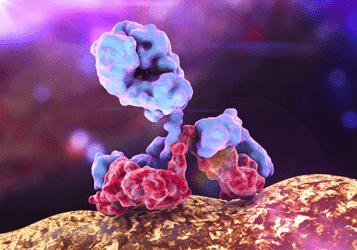- Home
- Products
- Customized ADCs
- Rabies Virus Glycoprotein
- Anti-Rabies Virus Glycoprotein (Rafivirumab)-SMCC-DM1 ADC
Anti-Rabies Virus Glycoprotein (Rafivirumab)-SMCC-DM1 ADC (CAT#: ADC-W-1958)
This ADC product is comprised of an anti-Rabies Virus Glycoprotein monoclonal antibody conjugated via a SMCC linker to DM1. The DM1 is targeted to certain cancers by immunerecognition and delivered into cancer cells via receptor mediated endocytosis. Within the cell, DM1 binds to tubulins, interrupts microtubule dynamics, and subsequently, induces cell death.
- ADC Target
- ADC Antibody
- ADC Linker
- ADC payload drug
- Name
- Rabies Virus Glycoprotein
- Alternative Names
- Rabies Virus Glycoprotein
- Overview
- This peptide is a 29 amino acid fragment derived from rabies virus glycoprotein (RVG). Because neurotropic viruses cross the blood-brain barrier to infect brain cells, the same strategy may be used to enter the central nervous system and deliver siRNA to the brain. This peptide specifically binds to the acetylcholine receptor expressed by neuronal cells.
- Overview
- Human Anti-Rabies Virus Glycoprotein IgG1-lambda antibody, Rafivirumab
- Generic name
- Rafivirumab
- Host animal
- Human
- Name
- SMCC (N-succinimidyl 4-(Nmaleimidomethyl)cyclohexane-1-carboxylate)
- Description
- Disulfide Linkers, are extensively exploited as a chemically labile linkage. Since the release of disulfide-linked drugs requires a cytoplasmic thiol cofactor, such as glutathione (GSH). Disulfides maintain stable at physiological pH and only when ADCs are internalized inside cells, the cytosol provides reducing environment including intracellular enzyme protein disulfide isomerase, or similar enzymes, drugs can be released.
- Name
- DM1 (N2'-Deacetyl-N2'-(3-mercapto-1-oxopropyl)maytansine)
- Description
- Derived from Maytansinoid,a group of cytotoxins structurally similar to rifamycin, geldanamycin, and ansatrienin. The eponymous natural cytotoxic agent maytansine is a 19-member lactam (ansa macrolide) structure originally isolated from the Ethiopian shrub Maytenus ovatus. Maytansinoids can bind to tubulin at or near the vinblastine-binding site, which interfere the formation of microtubules and depolymerize already formed microtubules, inducing mitotic arrest in the intoxicated cells.
For Research Use Only. NOT FOR CLINICAL USE.
Related Products
- Anti-TM4SF1-Mc-LP2 ADC-2 (CAT#: ADC-W-518)
- Anti-NRP1 (Vesencumab)-MC-MMAF ADC (CAT#: ADC-W-1678)
- Anti-EGFR (Matuzumab)-MC-MMAF ADC (CAT#: ADC-W-1036)
- Anti-IGF2 (Dusigitumab)-SPDB-DM4 ADC (CAT#: ADC-W-1269)
- Anti-PDCD1 (Pidilizumab)-SPDB-DM4 ADC (CAT#: ADC-W-1701)
- Anti-CD40 (Teneliximab)-SMCC-DM1 ADC (CAT#: ADC-W-902)
- Anti-CD74-Mc-MMAF ADC-1 (CAT#: ADC-W-039)
- Anti-CD2 (Siplizumab)-MC-Vc-PAB-SN38 ADC (CAT#: ADC-W-786)
- Anti-PCSK9 MC-Vc-PAB-DMEA-(PEG2)-duocarmycin SA ADC (CAT#: ADC-W-1687)
- Anti-MS4A1-SMCC-MDC ADC-2 (CAT#: ADC-W-129)
Published Data
+ Submit Publications

Scientific Resources
Customer Reviews and FAQs
There are currently no Customer reviews or questions for ADC-W-1958. Click the button above to contact us or submit your feedback about this product.
Quick Links
Other Products
Same Target
Same Linker
Same Payload
| CAT# | Product Name | Linker | Payload |
| ADC-W-1959 | Anti-Rabies Virus Glycoprotein (Rafivirumab)-SPDB-DM4 ADC | SPDB (N-succinimidyl-4-(2-pyridyldithio)butyrate) | DM4 (N2'-Deacetyl-N2'-(4-mercapto-4-methyl-1-oxopentyl)maytansine) |
| ADC-W-1963 | Anti-Rabies Virus Glycoprotein (Rafivirumab)-MC-Vc-PAB-DMEA-(PEG2)-duocarmycin SA ADC | MC-Vc-PAB-DMEA-(PEG2) | duocarmycin SA |
| ADC-W-1967 | Anti-Rabies Virus Glycoprotein (Foravirumab)-MC-Vc-PAB-MMAE ADC | MC-Vc-PAB (maleimidocaproyl-valine-citrulline-p-aminobenzoyloxycarbonyl) | MMAE |
| ADC-W-1961 | Anti-Rabies Virus Glycoprotein (Rafivirumab)-MC-Vc-PAB-MMAE ADC | MC-Vc-PAB (maleimidocaproyl-valine-citrulline-p-aminobenzoyloxycarbonyl) | MMAE |
| ADC-W-1964 | Anti-Rabies Virus Glycoprotein (Foravirumab)-SMCC-DM1 ADC | SMCC (N-succinimidyl 4-(Nmaleimidomethyl)cyclohexane-1-carboxylate) | DM1 (N2'-Deacetyl-N2'-(3-mercapto-1-oxopropyl)maytansine) |
| CAT# | Product Name | Linker | Payload |
| ADC-W-2589 | Anti-EGFR (Cetuximab)-SMCC-DM1 ADC | SMCC (N-succinimidyl 4-(Nmaleimidomethyl)cyclohexane-1-carboxylate) | DM1 (N2'-Deacetyl-N2'-(3-mercapto-1-oxopropyl)maytansine) |
| ADC-W-2583 | Anti-EGFR (Zalutumumab)-SMCC-DM1 ADC | SMCC (N-succinimidyl 4-(Nmaleimidomethyl)cyclohexane-1-carboxylate) | DM1 (N2'-Deacetyl-N2'-(3-mercapto-1-oxopropyl)maytansine) |
| ADC-W-473 | Anti-CD37-SMCC-DM1 ADC | SMCC (N-succinimidyl 4-(Nmaleimidomethyl)cyclohexane-1-carboxylate) | DM1 (N2’-Deacetyl-N2’-(3-mercapto-1-oxopropyl)maytansine) |
| ADC-W-495 | Anti-EGFR-SMCC-DM1 ADC-4 | SMCC (N-succinimidyl 4-(Nmaleimidomethyl)cyclohexane-1-carboxylate) | DM1 (N2’-Deacetyl-N2’-(3-mercapto-1-oxopropyl)maytansine) |
| ADC-W-2571 | Anti-SLC34A2 (Lifastuzumab )-SMCC-DM1 ADC | SMCC (N-succinimidyl 4-(Nmaleimidomethyl)cyclohexane-1-carboxylate) | DM1 (N2'-Deacetyl-N2'-(3-mercapto-1-oxopropyl)maytansine) |
| CAT# | Product Name | Linker | Payload |
| ADC-W-2521 | Anti-CD22 (Inotuzumab)-SMCC-DM1 ADC | SMCC (N-succinimidyl 4-(Nmaleimidomethyl)cyclohexane-1-carboxylate) | DM1 (N2'-Deacetyl-N2'-(3-mercapto-1-oxopropyl)maytansine) |
| ADC-W-2560 | Anti-MSLN (Anetumab )-SMCC-DM1 ADC | SMCC (N-succinimidyl 4-(Nmaleimidomethyl)cyclohexane-1-carboxylate) | DM1 (N2'-Deacetyl-N2'-(3-mercapto-1-oxopropyl)maytansine) |
| ADC-W-2583 | Anti-EGFR (Zalutumumab)-SMCC-DM1 ADC | SMCC (N-succinimidyl 4-(Nmaleimidomethyl)cyclohexane-1-carboxylate) | DM1 (N2'-Deacetyl-N2'-(3-mercapto-1-oxopropyl)maytansine) |
| ADC-W-2532 | Anti-CD22 (Pinatuzumab)-SMCC-DM1 ADC | SMCC (N-succinimidyl 4-(Nmaleimidomethyl)cyclohexane-1-carboxylate) | DM1 (N2'-Deacetyl-N2'-(3-mercapto-1-oxopropyl)maytansine) |
| ADC-W-2554 | Anti-CD79B (Polatuzumab )-SMCC-DM1 ADC | SMCC (N-succinimidyl 4-(Nmaleimidomethyl)cyclohexane-1-carboxylate) | DM1 (N2'-Deacetyl-N2'-(3-mercapto-1-oxopropyl)maytansine) |
Online Inquiry
Welcome! For price inquiries, please feel free to contact us through the form on the left side. We will get back to you as soon as possible.



